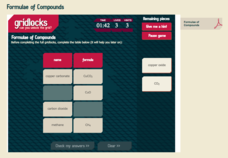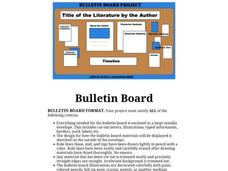Curated OER
Chemical Formulas and Naming
Students practice naming and writing formulas for simple chemicals. After a review of vocabulary, they create ion flash cards and discuss the rules for writing chemical compounds. They practice naming and writing the formulas based on...
Curated OER
What Information is on the Periodic Table?
In this elements instructional activity, students review the information that is found on a periodic table including atomic mass, chemical symbol, atomic, number, and electron configuration. This instructional activity has 7 fill in the...
Curated OER
Map Keys
In this geography worksheet, students identify who a cartographer is and what they do specifically. They study an outline map of a fictitious island and then, respond to the three questions that follow. Finally, students add three more...
Curated OER
Periodic Table Basics Make-Up Test
In this periodic table activity, students complete a table of elements with their atomic number, atomic mass and symbol. They classify elements by their group name and distinguish between metals, nonmetals, and semi-metals. They also...
Curated OER
Chemistry quiz
In this chemistry worksheet, students answer short answer and true and false questions about acids, bases, atoms, elements, and more. Students complete 20 questions.
Curated OER
My Favorite Holiday
Young scholars create a My Favorite Holiday Calendar Page. They recall the months of the year and identify the various components of a calendar. Students also apply their learning about holiday customs to consider their own favorite...
Curated OER
History of the Periodic Table
Students sort a group of manipulatives and then explain their organizational system to the class. They discuss the work of scientists trying to organize the elements into a system that made sense and the development of the periodic table.
Curated OER
Masses of Atoms
In this masses of atoms activity, high schoolers complete a chart of 7 isotopes with their isotope symbol, atomic mass, atomic number, and the number of protons, neutrons and electrons. They calculate the average atomic mass of two...
Curated OER
Atom Basics Test
Simple in format and standard in content, this resource is an assessment of your beginning chemists' grasp of the atom. Using a periodic table of elements, they fill in a chart of missing chemical formulas, atomic masses, and numbers of...
Curated OER
Element Names and Symbols
In this chemistry worksheet, students use an interactive website to study the names and symbols of elements. They give the names and symbols of 69 common elements.
Royal Society of Chemistry
Formulae of Compounds
Many people confuse the chemical formulas for copper carbonate and copper oxide. A set of challenging puzzles review commonly confused compound names and their symbols. Through a series of four puzzles, pupils match the names and...
Cornell University
The Making of Macromolecules
Compare and contrast macromolecules made from the same elements. Young scholars learn how the structure of a molecule has as much influence on a compound as the elements in the molecule. They experiment with molecular model kits to...
Shoop English
Literature Terms Activity
Designed to be used with an independent reading book, this activity provides practice with identifying and explaining literary terms. While they read, individuals find instances of literary devices and elements in use in their books....
Curated OER
Writing Ionic Formulas
The first 3 slides here give the steps of writing formulas once the components of a molecule are known. The ion charges are given and then ways of finding subscript assignments are demonstrated. The last page gives 3 examples of...
Curated OER
Naming III-Identifying Problems Chemical Compound Names
In this naming chemical compounds instructional activity, students are given 9 lettered statements that they use to match with 10 statements about compounds. Students also review the rules for naming compounds by filling in 25 blanks to...
Curated OER
Elements
In this elements worksheet, students write in the symbol of the chemical element that matches its description. This worksheet has 10 fill in the blank questions.
Curated OER
Atomic Structure
Students list the names and symbols of common elements. They describe the present model of the atom. Students describe how electrons are arranged in an atom. They identify quarks as particles of matter that make up protons and...
Curated OER
Periodic Table At A Glance
In this periodic table activity, learners fill in missing information such as atomic number, atomic mass, family name, etc. using the periodic table as their reference.
Monarch High School
TP-CASTT Practice
Acronyms can help learners remember facts and analyze poetry. This resource includes graphic organizers for TP-CASTT, SOAPS, SOAPSTone, and DIDLS. Class members can try out one or all of these strategies to assist with that difficult job...
Perkins School for the Blind
Polyatomic Ion Bingo
If your class is learning about polyatomic ions and needs a fun way to study those chemicals, then a bingo game might be right up your alley. This bingo game is intended to boost memorization skills, specifically the names of tricky...
Sandra Effinger
Bulletin Board Project
Imagine a project that informs and entertains. Replace book reports with a bulletin board that highlights all the important elements of a novel. Readers research the author, create a timeline of events in the story, write a...
Curated OER
The Periodic Table
Students examine the periodic table and how it was developed. In this chemistry instructional activity students identify common properties and uses of elements within a family.
Curated OER
The Chemistry of Mineral Worksheet
In this mineral worksheet, learners give the name and/or symbol for elements and they distinguish between elements and compounds. They fill in a chart with subatomic particles for given elements and they determine if given substances are...
Curated OER
Understanding Radon Detection
In this understanding radon detection worksheet, 6th graders read 8 facts about radon, make observations about and draw pictures of hidden objects, use a chart of elements to answer questions about radon.























